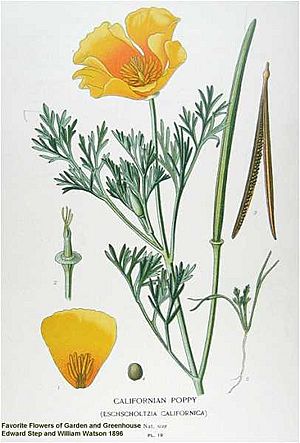Johann Friedrich von Eschscholtz facts for kids
Quick facts for kids
Johann Friedrich von Eschscholtz
|
|
|---|---|
 |
|
| Born | 12 November [O.S. 1] 1793 |
| Died | 19 May [O.S. 7] 1831 (aged 37) Dorpat, Kreis Dorpat, Governorate of Livonia, Russian Empire
(present-day Tartu, Tartu County, Estonia) |
| Nationality | Russian |
| Alma mater | Imperial University of Dorpat |
| Spouse(s) | Christine Friedrike Ledebour |
| Scientific career | |
| Fields | Botany, entomology |
| Institutions | University of Dorpat |
| Author abbrev. (botany) | Eschsch. |
Johann Friedrich Gustav von Eschscholtz (born November 1, 1793 – died May 7, 1831) was a Baltic German doctor, naturalist (someone who studies nature), and entomologist (someone who studies insects). He was one of the first scientists to explore the Pacific Ocean area. He collected many plants and animals in places like Alaska, California, and Hawaii.
Biography
Johann Eschscholtz was born in a city called Dorpat (now Tartu) in the Russian Empire. His family was Baltic German. He studied medicine and zoology at the University of Dorpat. He also worked as an assistant to Carl Friedrich von Ledebour, who was a professor of botany (the study of plants). Eschscholtz earned his medical degree in 1815.
First Voyage Around the World
Because of Ledebour's suggestion, Eschscholtz joined a Russian expedition. He worked as the surgeon and naturalist on the ship Rurik. This ship was led by Otto von Kotzebue.
From 1815 to 1818, the expedition sailed all the way around the world. Their goals were to find a Northwest Passage (a sea route through the Arctic) and to explore lands near the Pacific Ocean. Other scientists on the trip included botanist Adelbert von Chamisso and artist Louis Choris.
The Rurik left Russia on June 30, 1815. They stopped in the Canary Islands and then crossed the Atlantic Ocean to Brazil. In January 1816, they sailed around Cape Horn. They then went north for several months, reaching Kamchatka in July. For the rest of 1816, they visited the Aleutian Islands, California, and Hawaii.
At each stop, Eschscholtz collected plant and animal samples. He also wrote down his observations about the local nature. Eschscholtz and Chamisso worked well together and became good friends. In 1817, Kotzebue became sick. This meant they had to cut short their planned return to the Arctic. They headed home, stopping again in Hawaii and the Philippines. The voyage ended in Russia in August 1818.
After the trip, Kotzebue wrote a three-book story about the expedition. It included reports from Chamisso and Eschscholtz. Their collections of plants and animals were described in scientific journals. Eschscholtz's plant collections from California were published in a book. This was the first scientific description of California's plants. It was also the first time California was mentioned in the title of a science paper. He also published some of his insect discoveries.
After his first voyage, Eschscholtz married Christine Friedrike Ledebour. In 1819, he became an assistant professor at the University of Dorpat. Later, in 1822, he became the director of the university's zoological museum.
Second Voyage to the Pacific
In 1823, Kotzebue was asked to go back to the North Pacific. His mission was to resupply Kamchatka and protect the Russian American Company from smugglers. Eschscholtz agreed to join this second trip. He left Russia on July 28, 1823, aboard the ship Predpriaetie (Enterprise).
Again, Eschscholtz gathered many natural history samples. He especially collected a lot of insects. He found many insects in Hawaii, Alaska, and California. After a three-year journey, the expedition returned home in July 1826.
In 1830, Kotzebue and Eschscholtz published a report about their voyage. Eschscholtz also published illustrated descriptions of the new animals he found. He continued to work at the University of Dorpat. He was a professor of medicine and zoology and the director of the zoological museum.
Among the many insects he collected, about 100 butterflies and 20 beetles were new to science. Eschscholtz described some of them before he died. However, many others were described by different scientists. These included Carl Gustaf Mannerheim, Pierre François Marie Auguste Dejean, and Gotthelf Fischer von Waldheim.
Eschscholtz died on May 7, 1831, in Dorpat, Estonia. He was 37 years old.
Legacy
His friend and fellow scientist, Adelbert von Chamisso, named the California poppy (Eschscholzia californica) in his honor. Kotzebue also named an island in the Marshall Islands after him, calling it Eschscholtz Atoll. This island was later renamed Bikini Atoll in 1946. Kotzebue also named a small bay in Alaska after Eschscholtz, called Eschscholtz Bay.
Most of his collections were given to the University of Dorpat Museum and the Imperial Museum of Moscow.
See also
- Category:Taxa named by Johann Friedrich von Eschscholtz
- European and American voyages of scientific exploration
- List of Baltic German scientists



